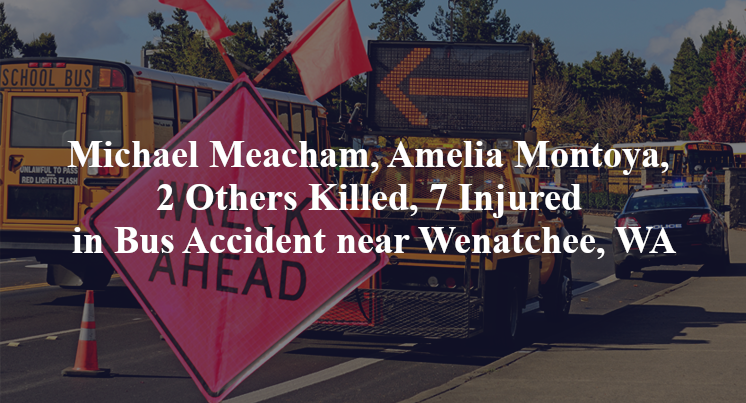Michael Meacham, Amelia Montoya, 2 Others Killed, 7 Injured in Bus Accident near Wenatchee, WA
Update (February 14, 2025): Authorities have identified the bus passenger killed in this crash as Amelia Montoya, 83. She died after being transported to a local hospital for treatment of injuries sustained in the crash.
Update (February 12, 2025): Authorities have identified the bus driver who was killed in this accident as Michael W. Meachem, 66. He was driving the bus on its regular route between Seattle and Spokane.
Chelan County, WA — February 9, 2025, four people were killed and 7 others were injured in a bus accident at about 1:40 p.m. on State Route 28.
Authorities said a Toyota Camry was trying to pass another vehicle while traveling west near Rock Island Dam Road when it crashed head-on into an eastbound charter bus. The collision forced the bus into a ditch along the road, while the Toyota also hit the Chevrolet Traverse it had been trying to pass.

Two teens in the Toyota and two people on the bus, including the 66-year-old driver, died in the crash southeast of Wenatchee, according to authorities.
Seven passengers, five women and two men, on the Northwest Stagelines bus were hospitalized with undisclosed injuries after the crash, authorities said. About 30 other bus passengers were not injured.
No injuries were reported for the occupants of the other vehicle involved in the crash.
Authorities have not released any additional information about the crash at this time. The accident remains under investigation.
Commentary
Head-on collisions are some of the most devastating crashes on the road, and when a smaller vehicle collides with a large bus, the results are often severe. Many people reading about this crash may assume that because the Toyota reportedly tried to pass another vehicle before the collision, the driver of that car is entirely accountable. That may turn out to be true, but as with any serious crash, the investigation needs to go beyond the initial details to determine exactly what led to this event.
One major question is whether passing in that location was reasonable. Was the Toyota attempting to pass in a legal passing zone, or was this an illegal maneuver? Even if the pass was allowed, did road conditions make it more dangerous than usual? Factors like visibility, road markings and the speed of traffic all play a role in whether a driver can safely execute a pass. Investigators should also examine whether other vehicles contributed to the crash: was the Chevrolet Traverse maintaining a steady speed, or did it slow unexpectedly, leaving the Toyota driver with fewer options?
The bus’s role in the crash also deserves scrutiny. Was the driver fully attentive, or did he have enough time to take evasive action? Charter buses, like commercial trucks, often have onboard monitoring systems that can provide critical information about the driver’s speed, braking and steering in the moments before impact. Authorities should also examine whether the bus was properly maintained: were the brakes and other safety systems in good working order?
Beyond the immediate circumstances of the crash, this incident raises questions about road design. Some two-lane highways create hazardous passing situations, especially if traffic flow and speed limits make it difficult for drivers to judge safe passing distances. If this particular stretch of road has a history of similar crashes, that would be worth looking into.
At this stage, there’s no way to say with certainty what caused this crash, but what’s clear is that there’s more to investigate than just a failed passing attempt. A thorough review of vehicle data, roadway conditions and driver actions is the only way to ensure that the right parties are held accountable and that lessons are learned to prevent similar wrecks in the future.

“These are essential reads for anyone dealing with the aftermath of a truck wreck”– Attorney Cory Carlson